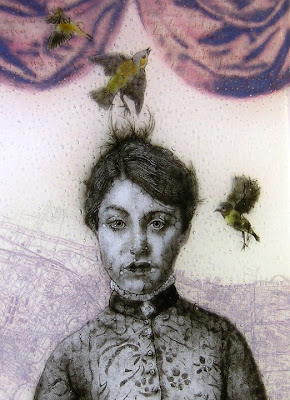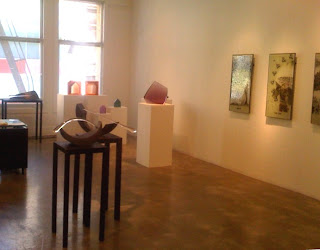>
Michael Janis was setting up a firing the other day of his thick layered glass panels, and the Washington Glass School blog asked how he created his frit powder drawings.



Detailed sketches are created to plan the layout each glass layer. Michael sifts frit powder onto sheet glass and manipulates with an scapel blade tip, scratching the powder until he is happy with the imagery (his version of sgraffito – or ” little scratch” technique.) Each working is fired into the glass, and aligned with the successive panel.
This process can take a number of weeks and requires multiple kiln firings. Once Michael is satisfied with the color depth of the frit powder application, he begins his set-up inside a kiln for the final firing – or full fuse.
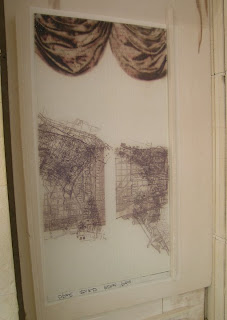


The panels are assembled into the kiln, sometimes with clear interlayers.

The top layer is placed in the kiln.
The kiln is then set for a long schedule to allow for proper annealing of 6 layers of bullseye glass.
After the glass cools, Michael then cleans and coldworks the slab, and prepares for mounting into one of his steel frames.
The piece shown here is titled “Somewhere I Have Never Traveled”, and will be shown by Maurine Littleton Gallery during SOFA Chicago.
Fourth of July Greetings
>
Cold + Hot Opens at San Francisco’s Micaela Gallery
>
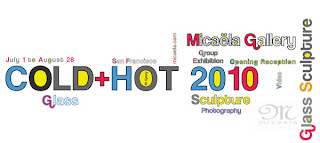
San Francisco’s Micaela Gallery opened its COLD + HOT exhibition. The word from the show was that the reception had a good turn out and there were several collectors at the opening.
I hear that there was a nice buzz around Tim Tate’s and Michael Janis’ work – congrats to the gallery and all the artists! Below are some cell phone photos of the gallery set-up.

Michael Janis’ work as seen from the main gallery.
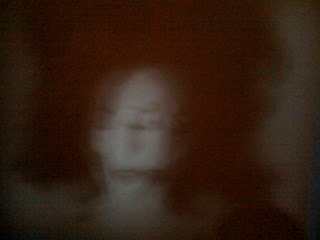
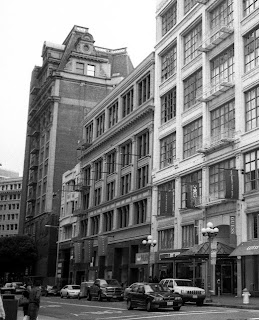
Micaëla Gallery
49 Geary Street, No. 234
San Francisco, CA 94108
415.551.8118 f 415.551.8138 info@micaela.com
Reality Check for Aspiring Artists
Micaela Gallery’s Cold + Hot
>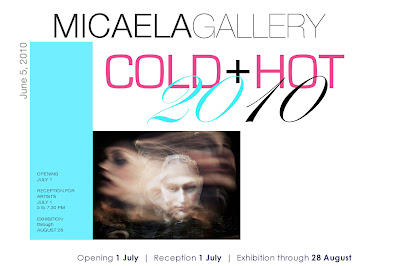 San Francisco’s Micaela Gallery features the work of Washington Glass School artists Michael Janis and Tim Tate in an exhibition of sculptural glass art titled COLD + HOT 2010.
San Francisco’s Micaela Gallery features the work of Washington Glass School artists Michael Janis and Tim Tate in an exhibition of sculptural glass art titled COLD + HOT 2010.
Micaela Gallery showcases fine art and sculpture, and was one of the best of the US galleries featured at Art Basel, Switzerland. The title Cold + Hot references the processes used by glass artists to form the medium. Featured glass artists include: Peter Bremers, Kathleen Elliot, Michael Janis, Michelle Knox, Weston Lambert, Carol Lawton, Silvia Levenson, Susan Longini, Thomas Scoon, Carmen Spera, Tim Tate and Kristina Uslar.
Tim Tate, whose cross-over work of digital media and video pushes the debate between fine art and craft will be showing his videos in the photograph/video gallery within the main art gallery, along with photographs by Mark Leibowitz.
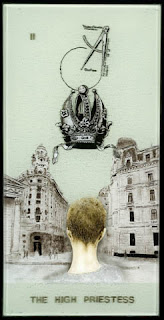
Michael Janis
‘The High Priestess Tarot’
kilncast glass, glass powder imagery, steel
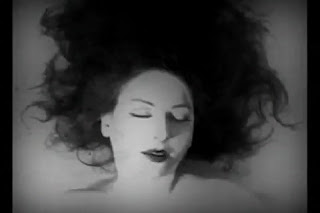
Tim Tate
‘Dreaming of Ophelia’
Original Video
49 Geary Street, No. 234
San Francisco, CA 94108
415.551.8118
Hirshhorn – Tear Down These Walls
>
 Tim Tate with Marc Petrovic Cure for Intelligent Design
Tim Tate with Marc Petrovic Cure for Intelligent Design
 detail of Cure for Intelligent Design
detail of Cure for Intelligent DesignPart of “Dead or Alive” exhibit at NYC’s Museum of Arts and Design
photography by Anything Photographic
A Facebook campaign to get Tim Tate’s work into the Hirshhorn Museum is underway. The group is dedicated to dedicated to convincing the curatorial staff and acquisition committee of the Hirshhorn Museum and Sculpture Garden to finally purchase and exhibit some of the amazing video art pieces from Tim Tate.
The Washington Glass School’s Tim Tate is one of the most renowned award winning artists in this region. He works in self-contained video installations and projections.
Click HERE to jump to the Facebook group.
Tim has four exhibits on right now:
– Swanson Reed Gallery, Louisville, KY.
– Fuller Museum, Brockton, MA.
– Scope Art Basel, Switzerland with San Francisco’s Micaela Gallery, June 15-20, 2010
– Museum of Arts and Design, Dead or Alive, New York, NY
Founding Director of Corning Museum of Glass Dies at 83
>Thomas S. Buechner, who was the founding director of the Corning Museum of Glass and was the director of the Brooklyn Museum in the 1960’s, died on Sunday at his home in Corning, NY. He was 83.
Mr Buechner, a painter and illustrator, served for 10 years as the director of the Corning Museum of Glass before becoming director of the Brooklyn Museum in 1960. At 33, he was one of the youngest museum directors in the United States. He recently had a retrospective of his artwork exhibited at Alexandria’s Principle Gallery.
Click HERE to jump to the NY Times obit on Thomas Buechner.
Corning Museum of Glass Call For Entries
>
Each year, The Corning Museum of Glass conducts a worldwide competition to select 100 images of new works in glass. A committee drawn from designers, artists, curators, and critics makes the selection. The publication is intended to keep its audience, which includes museums, artists, libraries, collectors, scholars, and dealers, informed of recent developments in the field. Objects considered excellent from any of several viewpoints—such as function, subject matter, aesthetics, and technique—will be chosen. The objects selected will be published in color with the names of the makers and brief descriptions of the pieces. 
Participants are requested to complete the entry form, submitting a total of three digital images illustrating one work per image. Digital photographs, which should be made using the highest-resolution setting on the camera, must be of actual objects designed and made between October 1, 2009, and October 1, 2010.
Click HERE to jump to CMOG entry prospectus.
Click HERE to see some of the winners of New Glass Review 31.
Tim Tate @ Art Basel, Switzerland
>At its inaugural exhibition at SCOPE Basel 2010, Micaëla Gallery (USA) introduces: Marvin Lipofsky, Nicole Schmoelzer, Prema Murthy, Lorraine Peltz, Scott Kildall, Silvia Levenson and Tim Tate.
San Francisco’s Micaëla Gallery will feature contemporary fine art with an exhibition of digital drawings (Murthy), explorations of light (Lipofsky, Schmoelzer), and dialogue addressing social concerns (Levenson, Tate, Kildall, Peltz), Micaela Gallery introduces artworks by gallery artists that are as beautiful to regard as they are engaging to the intellect.
Each artist was carefully chosen because of singular contributions to contemporary visual dialogues.
 |
Marvin Lipofsky, educator, inveterate traveler, multi-awarded artist, respected sculptor, and passionate supporter of the arts, is credited with bridging international communities of artists through ideological barriers, over time and across continents to become a fundamental pillar of the international glass community. Working with established and respected artists from the Czech Republic, Venice, China and the United States, his collaborative sculptures can be found in important museum and private collections worldwide. A master colorist, Lipofsky’s work pays homage to the communities where he created his work. For example, during his visit to the Czech Republic, his sculpture referenced landscape and political climate, while the work he made during his visit to China used colors that traditionally augur joy and prosperity in Chinese communities. Lipofsky’s work also addresses the manner that light shifts through space as well as the effect on space that his work occupies, in terms of color and texture. He established the respected glass programs at the University of California at Berkeley and the California College of Art; and resides in Berkeley, California.
 |
Nicole Schmoelzer, a life-long student of painting, works with oil paint on linen and paper, developing series of paintings where the behavior of color is the topic. She is an abstract painter, who loves the interaction of colors, with and against each other. By investigating the manner that color performs on a surface or structuring quality, Schmoelzer is excited by the possibilities of illustrating simultaneously different layers of movements and shifts on the visual plane. Her work begins by setting stains – staining – the surface, with liquid oil paint. By building layers, which are subsequently exposed, newly exposed washes of paint take on an illusion of depth, receding to, or surfacing from, an in-between imaginary third-dimensional space. Schmoelzer’s current work incorporates ink with oil paint, and, by process and composition, mediates between the organic and geometric, in expression and approach. She resides in Brooklyn, New York and Basel, Switzerland.
 |
Prema Murthy is a mathematician who decided the best way to address her love of beautiful mathematical theory is to work with it visually. TECTONICS is a series of archival digital prints that explore ruptures in the structural features of globalization. Murthy’s starting points for the project are scientific mapping of natural phenomena and concepts in eastern philosophy relating to embodiment, cognition, and Mind. Between these geographical and cognitive sites, she uses the human body as a metaphor where effects of globalization manifest in terms of simultaneous disintegration and reintegration. She combines drawing techniques with digital processes to map the body in terms of dynamic states of power – continuously shifting spheres of influence that effect geographical, as well as political, economic, and mental terrain as well. In her work, bodies become a drawing tool to map unseen traces of energy, motion and the passage of time. Based in New York, Murthy received her MFA from Goldsmiths College, London.
 |
Lorraine Peltz‘ work is a continuing discussion of feminine ideas in a fresh, beautiful manner in relation to place and identity. Her vernacular uses recognizable, highly charged images that explore women’s fantasies and desires. Peltz’ mimicry and reconciliation of how information comes to us and how meaning is made — real life alongside memory, poetry next to prose — become the landscapes of her exterior world and an interior space of dream, desire, hope, and memory. Images of chandeliers, among others, co-mingle the language of 17th century-esque still-life objects and pop imageries of lightening bolts, puffy clouds, painted lips, ominous blackbirds, and more. Peltz received her MFA from the University of Chicago. She lives and works in Chicago and teaches at the School of the Art Institute of Chicago.
 |
Scott Kildall works at the intersection of media culture and human memory. His artwork depicts collapse: between producer and consumer, viewer and viewed and simulated and real. He appropriates material, bends rules of consent, restages events and invites viewers to alter his exhibited pieces. These acts and products reflect a shift in cultural production – where ownership dips into a zone of ambiguity and image and sound is widely recycled. Lately, Kildall has been using Second Life – an online world with simulated physical space – as a site for artistic inquiry. A graduate of the San Francisco Art Institute MFA program, Kildall resides in San Francisco and New York City.
 |
Silvia Levenson addresses life and femininity with wry wit and beautiful work. Her work addresses daily living and the veiled anguish within the home, offering viewers a dark and comic window of not so blissful family life. Socially concerned with the influences of modern self medication, as a method of coping with what she calls the cocoon and the battlefield: a place of love, hate, and tension; her work displays dualities of fragility and imperviousness – best conveyed through her mediums of glass and video. Levenson purposefully exploits her personal experiences as wife, mother, daughter, and sister to express the fragility and complexity of her oeuvres. Much of Levenson’s art is an attempt to resolve the difficulties of living with threats of violence, political and domestic, that are out of our control. Born in Argentina, Levenson now resides in Italy.
 |
Tim Tate is an artist with a rare appreciation for the beauty of life – he perceives his sculptures as self-contained video installations. Blending a traditional craft with new media technology gives him the framework in which to fit his artistic narrative. Revelation, and in some cases self-revelation, is the underlying theme of his electronic reliquaries. Tate understands his interactive works may disturb because it prompts a variety of responses: amusement, memory, and maybe, recognition. But he values the viewer’s response to his hybrid art work and its conceptual nature. Tate defines his work as phylacteries of sorts, the transparent reliquaries in which bits of saints’ bones or hair, relics, are displayed. In many cultures and religions, relics are believed to have magical or spiritual powers, especially for healing. Tate’s relics are temporal, sounds and moving images formally enshrined, encapsulating experiences like as a collection of cultural specimens. Tate works and lives in Washington DC.
FirstView Party and Reception: FirstView for all VIPs or 100 CHF donation at the door
Tuesday June 15 3 – 7pm
PressView: Tuesday June 15 3 – 7pm
RSVP to press@scope-art.com
Serving cocktails and hors d’oeuvres to our guests and exhibitors.
General Fair Hours
Wednesday June 16 11am – 7pm
Thursday June 17 11am – 7pm
Friday June 18 11am – 7pm
Saturday June 19 11am – 7pm
Admission
Free for VIP cardholders
General Wednesday – Saturday CHF 20
Student Wednesday – Saturday CHF 10
Location
Kaserne Basel
Klybeckstr. 1b
CH – 4057 Basel
Fuller Craft Museum "The New Materiality"
>
 The Fuller Craft Museum‘s new show: The New Materiality: Digital Dialogues at the Boundaries of Contemporary Craft has its Opening Reception this weekend.
The Fuller Craft Museum‘s new show: The New Materiality: Digital Dialogues at the Boundaries of Contemporary Craft has its Opening Reception this weekend.
Curated by Fo Wilson, the artists in this exhibition combine new technologies – digital video, computerized design – with traditional craft materials to forge new artistic visions. The Washington Glass School’s Tim Tate is one of the featured artists in the show.
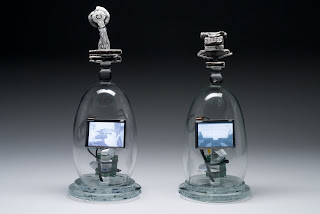
Sunday, June 13, 2010, 1pm
“A Twenty-first Century View of Craft”, lecture with Fo Wilson.
Fo will discuss how the artists of ‘The New Materiality’ are adapting, manipulating and re-inventing the materials of craft in a digital age.
Sunday, June 13, 2010, 2pm
Opening Reception
455 Oak Street
Brockton, MA 02301
